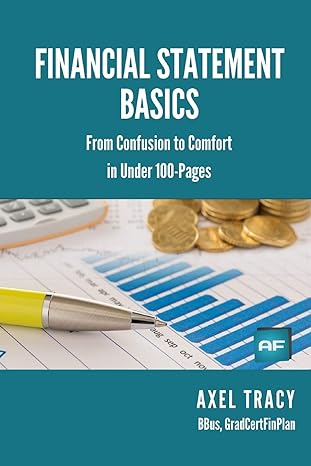Answered step by step
Verified Expert Solution
Question
1 Approved Answer
Required information [The following information applies to the questions displayed below.] Simon Company's year-end balance sheets follow. At December 31 Assets Current Year 1 Year
Required information [The following information applies to the questions displayed below.] Simon Company's year-end balance sheets follow. At December 31 Assets Current Year 1 Year Ago 2 Years Ago $ 33,735 100,768 $ 40,238 71,825 Cash Accounts receivable, net Merchandise inventory Prepaid expenses Plant assets, net Total assets 122,933 11,307 314,708 $ 583,451 Liabilities and Equity Accounts payable $ 149,638 Long-term notes payable Common stock, $10 par value Retained earnings Total liabilities and equity 107,495 163,500 162,818 90,259 10,668 289,985 $ 502,975 $ 86,703 113,371 163,500 139,401 $ 583,451 $ 502,975 For both the current year and one year ago, compute the following ratios: $ 43,613 55,327 60,126 4,564 264,070 $ 427,700 $ 56,456 96,412 163,500 111,332 $ 427,700 The company's income statements for the current year and one year ago follow. Assume that all sales are on credit: For Year Ended December 31 Sales Cost of goods sold Other operating expenses Interest expense Income tax expense Total costs and expenses Net income Current Year 1 Year Ago $ 758,486 $ 598,540 $ 462,676 235,131 $ 389,051 151,431 13,766 8,978 12,894 9,860 720,561 $ 37,925 563,226 $ 35,314 Earnings per share (1-a) Compute days' sales uncollected. $ 2.33 (1-b) Determine if days' sales uncollected improved or worsened in the current year. (2-a) Compute accounts receivable turnover. $ 2.17 (2-b) Determine if accounts receivable turnover ratio improved or worsened in the current year. (3-a) Compute inventory turnover. (3-b) Determine if inventory turnover ratio improved or worsened in the current year. (4-a) Compute days' sales in inventory. (4-b) For each ratio, determine if days' sales in inventory improved or worsened in the current year. Complete this question by entering your answers in the tabs below. Required 1A Required 1B Required 2A Required 2B Required 3A Required 3B Required 4A Required 4B Compute days' sales uncollected. Current Year: 1 Year Ago: Numerator: 1 Days' Sales Uncollected Denominator: Days Days' Sales Uncollected Days' sales uncollected 0 days < Required 1A Required 1B > 0 days Determine if days' sales uncollected improved or worsened in the current year. Days' sales uncollected Compute accounts receivable turnover. (Round your answers to the nearest whole number.) Accounts Receivable Turnover Current Year: 1 Year Ago: Numerator: I 1 Denominator: Accounts Receivable Turnover Accounts receivable turnover = 0 times = 0 times Determine if accounts receivable turnover ratio improved or worsened in the current year. Accounts receivable turnover Compute inventory turnover. (Round your answers to the nearest whole number.) Inventory Turnover Current Year: 1 Year Ago: Numerator: Denominator: Inventory Turnover = Inventory turnover = 0 times = 0 times Determine if inventory turnover ratio improved or worsened in the current year. Inventory turnover Compute days' sales in inventory. Days' Sales In Inventory Current Year: 1 Year Ago: Numerator: 1 1 Denominator: x Days = Days' Sales In Inventory x = Days' sales in inventory x = 0 days x = 0 days For each ratio, determine if days' sales in inventory improved or worsened in the current year. Days' sales in inventory
Step by Step Solution
There are 3 Steps involved in it
Step: 1

Get Instant Access to Expert-Tailored Solutions
See step-by-step solutions with expert insights and AI powered tools for academic success
Step: 2

Step: 3

Ace Your Homework with AI
Get the answers you need in no time with our AI-driven, step-by-step assistance
Get Started


